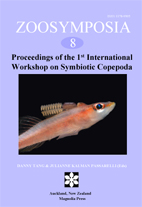Abstract
The spatial distribution of two parasitic copepods, Acantholochus zairae Morales-Serna & Gómez, 2010 (Poecilostomatoida: Bomolochidae) and Pseudochondracanthus diceraus C. B. Wilson, 1908 (Poecilostomatoida: Chondracanthidae), was analyzed on the gills of the bullseye pufferfish Sphoeroides annulatus (Jenyns). A positive association between A. zairae and P. diceraus was observed; however, species coexistence is facilitated because intraspecific aggregation was stronger than interspecific aggregation. Each copepod species was less frequent on the middle arch regions. Pseudochondracanthus diceraus showed a preference for the third gill arch (the innermost), as well as for the dorsal region of the gill arches and the middle zone of the gill filaments. Acantholochus zairae was randomly distributed among gill arches, but showed a preference for the ventral region of the gill arches and the middle zone of the gill filaments. In addition, only A. zairae appeared to be affected by increasing host length. It is possible that water flowing through the branchial cavities of S. annulatus is a major determinant on the distribution of its gill copepods.

